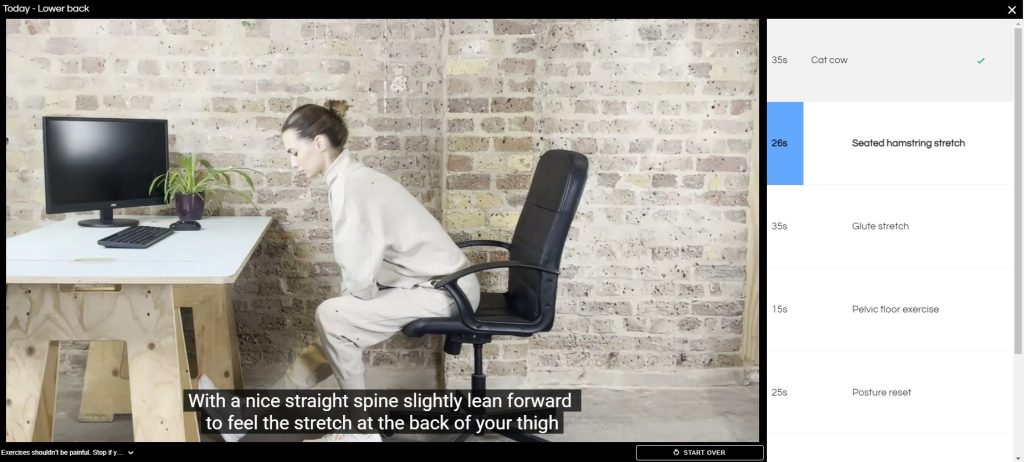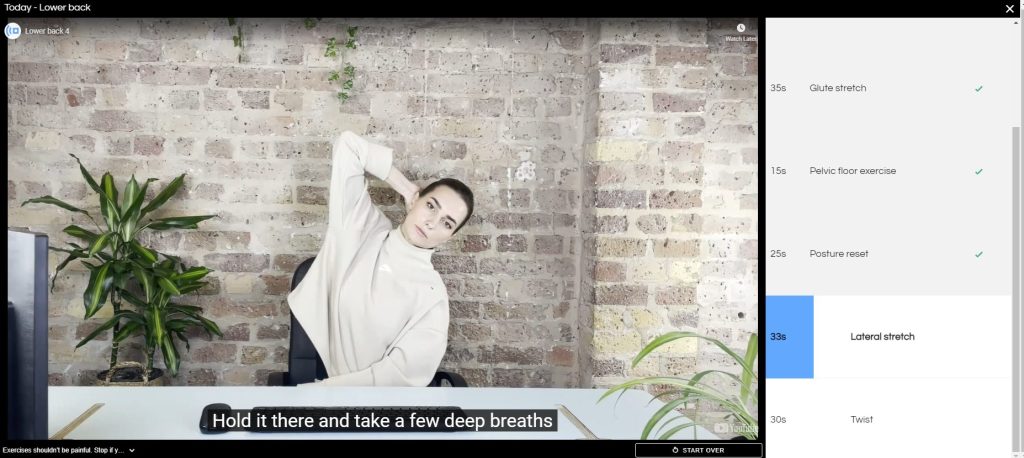Exercise and physiotherapy often play a crucial role in the treatment of chronic pain. Exercise can help prevent chronic pain and improve muscle strength and flexibility. Physiotherapy, on the other hand, is a specialised form of treatment which often includes targeted exercises and other treatment methods to help alleviate pain, improve mobility and prevent future injuries.
Physiotherapy and exercise can both significantly improve your physical wellbeing and quality of life. In this blog, we’ll take a look at how short exercises compare to traditional physiotherapy for reducing pain.
What is physiotherapy?
Physiotherapy, also known as physical therapy, is a branch of healthcare that focuses on the diagnosis, treatment and prevention of physical injury and pain. Physiotherapy is used to treat a wide range of conditions, including musculoskeletal injuries, neurological disorders, respiratory problems and chronic pain.
Physiotherapy aims to help patients restore or improve their physical function, mobility and strength. To achieve this, physiotherapists use a variety of techniques including exercise, manual therapy, electrotherapy and education. The specific treatment plan for each patient will depend on their individual needs, medical history and goals.

What is VIDA Pain Coach?
VIDA Pain Coach is a personalised pain management programme with short, easy-to-follow exercises that can be performed in the office or at home with minimal equipment. This makes it an ideal solution for people who may be limited in traditional forms of exercise due to time or work constraints.
The exercises within Pain Coach are designed to target pain in specific areas of your body, such as your neck, back or extremities, tailored to meet your individual needs.
VIDA Pain Coach’s short exercise videos have been scientifically proven to reduce pain.
In our large cohort case study, individuals who participated in Pain Coach’s short exercises experienced a significant reduction in their pain score by 2.2 points out of 10.

What is the difference between VIDA Pain Coach and physiotherapy?
Whilst VIDA Pain Coach’s short exercises and traditional physiotherapy are both effective ways to reduce pain, there are essential differences between the two approaches.
Short exercise videos are a convenient and cost-effective way to incorporate physical activity into your daily routine. Physiotherapy, on the other hand, is a highly specialised and personalised form of treatment that is effective in managing a wide range of physical conditions and injuries.
Comparing VIDA pain coach with Physiotherapy
After conducting extensive research on pain reduction in physiotherapy, we compared the results from several noteworthy studies to our results from VIDA Pain Coach. We found that our VAS pain-reduction score of 2.2 was similar to the average reduction of 2.58 points in the studies on physiotherapy, which ranged from 1 to 3.84 points. However, the studies on physiotherapy took an average of 229 minutes to achieve these results, whereas VIDA Pain Coach only took 14.85 minutes. [1-6]
| Average VAS reduction | Average time required | |
| VIDA Pain Coach | 2.22 | 14.85 minutes |
| Physiotherapy [1-6] | 2.58 | 229 minutes |
VIDA offers several benefits, such as its ease of access and lack of required travel time. However, physiotherapy provides advantages such as various treatment methods, including hot pack therapy, transcutaneous electrical nerve stimulation, short-wave diathermy (crossfire method), and others.

Is it safe to use VIDA Pain Coach if I have specific medical conditions?
The stretching and gentle strengthening exercises offered by VIDA Pain Coach are versatile and adaptable, making them suitable for a wide range of purposes. In fact, these exercises are generally well-suited for most individuals, unless specifically advised otherwise by a doctor.
However, it is essential to note that in some cases, individuals may not be suitable for certain stretches or workouts due to medical or health-related reasons. It’s always essential to consult with a doctor or healthcare professional before starting any new exercise programme, especially if you have any pre-existing medical conditions or injuries.

In Summary
When it comes to managing pain, it’s essential to work with medical professionals who can assess your condition and recommend the most effective treatment options. VIDA Pain Coach and physiotherapy are both valuable approaches for managing pain, each with its own unique benefits.
While VIDA can be an excellent tool for improving your physical wellbeing, it’s important to note that it should not replace the recommended weekly exercise time suggested by the NHS. Instead, it can complement your exercise routine by providing a convenient way to stay active throughout the day.
Many people believe they can undo the negative effects of prolonged sitting by engaging in intense exercise a few times a week. However, this is not always effective in managing pain and improving physical function. Taking regular short exercise breaks throughout the day can be more beneficial in promoting good posture and reducing pain.
By incorporating VIDA Pain Coach into your daily routine, you can take advantage of the benefits of short exercise breaks to improve your overall physical wellbeing. While it may not replace your weekly recommended exercise, it can provide a valuable supplement to your existing exercise routine, helping you to stay active and maintain good posture throughout the day.
For more information on how VIDA can help you improve your pain, get in touch with us at sales@vitruehealth.com or try out VIDA yourself for free!

References
[1] Gridley, L., & van den Dolder, P. A. (2001). The Percentage Improvement in Pain Scale as a measure of physiotherapy treatment effects. Australian Journal of Physiotherapy, 47 (2), 133-138.
[2] Zavarize, S. F., Paschoal, M. A., & Wechsler, S. M. (2016). Effects of physiotherapy associated to virtual games in pain perception and heart rate variability in cases of low back pain. Manual Therapy, Posturology & Rehabilitation Journal, 1–7.
[3] Kim, K., Min, A., Jeon, C., Kim, T., Cho, S., Lee, C., & Lee, K. (2020). Clinical outcomes and cost-effectiveness of massage chair therapy versus basic physiotherapy in lower back pain patients: A randomized controlled trial. Medicine, 99(12).
[4] Špringrová, I., Krejčová, A., Bendíková, E., Tomková, Š., Łubkowska, W., and Mroczek, B. (2020). Comparison of the impact of two physiotherapeutic methods on pain and disability in patients with non-specific low back pain: a controlled clinical pilot study. Family Medicine & Primary Care Review, 22(2), pp.146-151.
[5] Namiranian P, Karimi M, Razavi SZE, Garoos AF, Ayati MH. Comparison of an Iranian Traditional Massage (Fateh Method) with Physiotherapy and Acupuncture for Patients with Chronic Low Back Pain: a Randomized Controlled Trial. J Acupunct Meridian Stud. 2022 Jun 30;15(3):163-173.
[6] Kirthika, Veena. (2018). Efficacy of Combined Proprioceptive Exercises and Conventional Physiotherapy in Patients with Osteoarthritis Knee Joint: A Double-Blinded Two-Group Pretest–Posttest Design. Journal of Orthopedics, Traumatology and Rehabilitation.





